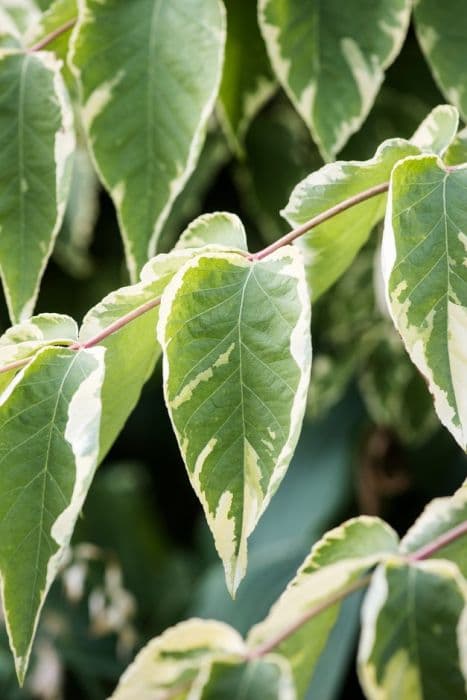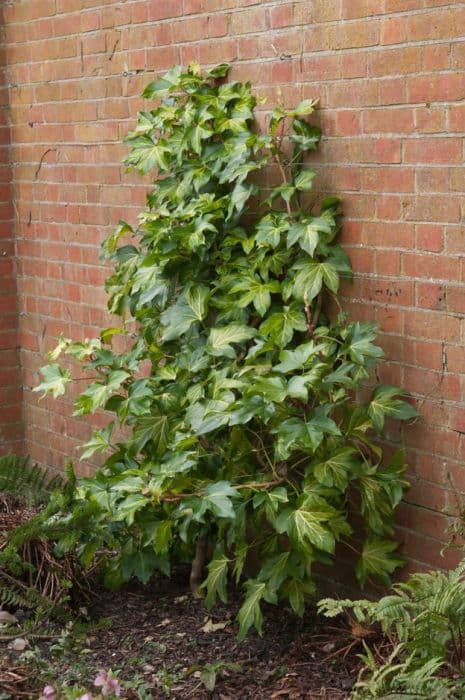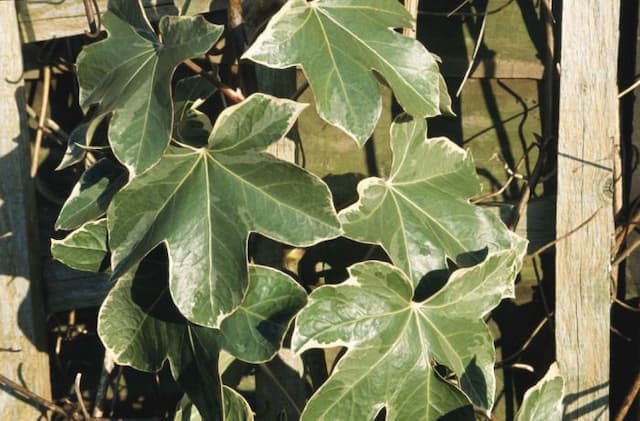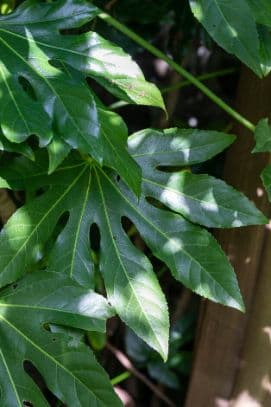Algerian Ivy Hedera algeriensis 'Marginomaculata' (v)

ABOUT
The plant commonly known as the Variegated Algerian Ivy, Hedera algeriensis 'Marginomaculata' (v), is a striking variety that immediately catches the eye with its ornamental foliage. The leaves are notable for their large, heart-shaped form, exuding a robust and lush appearance. Their texture can be described as leathery, providing a sense of sturdiness to the overall aesthetic of the plant. One of the most distinguishable features of this ivy variety is the coloring of the leaves. Each leaf exhibits a vibrant green backdrop that is beautifully edged with creamy white to yellow margins. The contrast between the green center and the variegated edges gives the foliage a dynamic and decorative quality. Adding even more interest, some of the leaves may have splashes or speckles of gray-green, which vary in intensity and pattern, making each leaf uniquely attractive. As a climbing or ground-covering plant, the Variegated Algerian Ivy drapes and extends itself with grace. Its stems bear a certain level of flexibility, which allows the plant to climb surfaces or spread horizontally when used as a ground cover, though without reference to the actual lengths it may achieve. In summary, the aesthetic of the Variegated Algerian Ivy is one of both vivid color contrast and substantial, heart-shaped leaves, creating a tapestry of variegated hues and a powerful presence, whether used in outdoor landscaping or as a decorative indoor plant.
About this plant
 Names
NamesFamily
Araliaceae.
Synonyms
Algerian Ivy, Variegated Algerian Ivy, Canary Island Ivy, North African Ivy.
Common names
Hedera canariensis var. algeriensis 'Marginomaculata', Hedera algeriensis 'Gloire de Marengo'
 Toxicity
ToxicityTo humans
The plant commonly known as Algerian Ivy is considered to be toxic to humans if ingested. Its leaves contain triterpenoid saponins which can cause gastrointestinal disturbances and possibly even dermatitis from skin contact for sensitive individuals. Symptoms of poisoning if ingested may include nausea, vomiting, abdominal pain, diarrhea, and hypersalivation. In severe cases, if large quantities are consumed, the poisoning can lead to more serious symptoms such as fever, muscle weakness, and coordination problems. However, only experiencing mild symptoms is more common. It is always advised to keep this plant out of reach of children and teach them not to ingest any part of it.
To pets
Algerian Ivy is toxic to pets if ingested. The culprit is the triterpenoid saponins found in the plant. If your pet consumes any part of the Algerian Ivy, it might show symptoms such as vomiting, abdominal pain, hypersalivation, and diarrhea. In severe cases, ingestion could lead to more serious health issues like tremors, muscle weakness, or difficulty in breathing, although these more extreme reactions are less common. It's important to keep pets away from this plant and consult a veterinarian if you suspect your pet has ingested any part of it.
 Characteristics
CharacteristicsLife cycle
Perennials
Foliage type
Evergreen
Color of leaves
Variegated
Height
6-10 feet (1.8-3 meters)
Spread
3-50 feet (1-15 meters)
Plant type
Climber
Hardiness zones
7-11
Native area
North Africa
Benefits
 General Benefits
General Benefits- Aesthetic Appeal: Adds visual interest to garden spaces with its variegated foliage.
- Versatility: Suitable for growing both indoors and outdoors in various climates.
- Low Maintenance: Requires minimal care once established, making it ideal for both novice and experienced gardeners.
- Growth Habit: Excellent for creating ground cover, reducing soil erosion, and suppressing weeds.
- Climbing Ability: Can be trained to climb walls, fences, and trellises, providing a green facade.
- Durability: Tolerates a range of soil types and can withstand some neglect.
- Seasonal Interest: Evergreen nature provides year-round greenery in landscapes.
 Medical Properties
Medical PropertiesThis plant is not used for medical purposes.
 Air-purifying Qualities
Air-purifying QualitiesThis plant is not specifically known for air purifying qualities.
 Other Uses
Other Uses- Algerian Ivy 'Marginomaculata' can be used to create topiaries in gardens, where the ivy is trained to grow over wire frames, forming various shapes like animals or geometric patterns.
- The dense foliage of Algerian Ivy 'Marginomaculata' offers privacy when grown as a screen or hedge in residential or urban environments.
- Creative arts and crafts projects may incorporate Algerian Ivy 'Marginomaculata', as the variegated leaves can add texture and color to floral arrangements, wreaths, or potpourris.
- Algerian Ivy 'Marginomaculata' can be used in theme gardens, such as an “Alice in Wonderland” garden, to create the feel of an old English setting with overgrown ivy.
- This plant can be used as a natural dye source, where the leaves provide subtle green hues for fabrics or paper products.
- Algerian Ivy 'Marginomaculata is used for educational purposes, helping students understand plant propagation through stem cuttings and root development.
- Film and theatre sets sometimes use Algerian Ivy 'Marginomaculata' to create realistic-looking ancient ruins, abandoned properties, or to evoke an "overgrown" aesthetic.
- The vigorous growth of Algerian Ivy 'Marginomaculata' makes it suitable for covering unsightly features in the landscape, such as old tree stumps or decaying fences.
- Gardeners may use this ivy in mixed containers or hanging baskets, where it provides a cascading effect that contrasts well with flowering annuals or perennials.
- Algerian Ivy 'Marginomaculata' can also serve as a living mulch, covering the ground with a carpet of foliage that helps retain soil moisture and suppress weeds.
Interesting Facts
 Feng Shui
Feng ShuiThe Algerian Ivy is not used in Feng Shui practice.
 Zodiac Sign Compitability
Zodiac Sign CompitabilityThe Algerian Ivy is not used in astrology practice.
 Plant Symbolism
Plant Symbolism- Friendship and Affection: The Algerian ivy, or Hedera algeriensis 'Marginomaculata' (v), often symbolizes emotional bonds, suggesting its tendency to entwine and support itself on various structures, representing the interconnected nature of friendships.
- Fidelity: Given its clinging growth habit, Algerian ivy is also associated with faithfulness and wedded love, reminiscent of clinging to a partner and supporting one another.
- Eternal Life: The evergreen nature of Algerian ivy represents continuity and eternal existence, often used in religious and funerary contexts to signify everlasting life or memory.
- Protection: With its dense coverage, Algerian ivy can symbolize shelter and protection, metaphorically providing a barrier against adversity.
- Prosperity and Growth: The vigorous growth of Algerian ivy can represent progress, success, and the flourishing of ideas or ventures, much like the plant's own expansion in its natural habitat.
 Water
WaterAlgerian ivy should be watered when the top inch of soil feels dry to the touch. This typically means watering once every seven to ten days, but it can vary based on environmental factors such as temperature and humidity. The watering method should thoroughly saturate the soil, ensuring even moisture distribution. Depending on the size of the pot, usually between 16 to 32 ounces of water will be sufficient each time you water. It's important to avoid overwatering and ensure the pot has proper drainage to prevent root rot.
 Light
LightAlgerian ivy thrives in bright, indirect light but can also adapt to low light conditions. The best spot for the plant would be near a window where it can receive filtered sunlight. Direct sunlight should be avoided as it can scorch the leaves. If natural light is limited, consider using artificial plant lights to supplement.
 Temperature
TemperatureAlgerian ivy prefers temperatures between 50 to 70 degrees Fahrenheit for optimal growth, but can tolerate a range down to the mid-30s and up to the high 80s in Fahrenheit. Keeping the plant in a location where temperature fluctuations are minimal is ideal. It is particularly important to protect the plant from cold drafts and sudden drops in temperature, which can damage the foliage.
 Pruning
PruningPruning Algerian ivy is necessary to maintain its shape and encourage bushier growth. It should be pruned in the spring or early summer, cutting back any overgrown or leggy stems. Occasional trimming can be done throughout the year to remove any dead or damaged leaves and stems. This helps in improving the overall appearance and health of the plant.
 Cleaning
CleaningAs needed
 Soil
SoilAlgerian Ivy 'Marginomaculata' thrives in well-draining soil rich in organic matter, with a preferred pH of 5.5 to 6.5. A mix of peat, pine bark, and perlite or sand works well to ensure adequate drainage and aeration.
 Repotting
RepottingAlgerian Ivy 'Marginomaculata' should generally be repotted every two to three years to prevent it from becoming root-bound and to refresh the soil.
 Humidity & Misting
Humidity & MistingAlgerian Ivy 'Marginomaculata' prefers moderate to high humidity levels but is adaptable and can tolerate a wide range of indoor humidity conditions.
 Suitable locations
Suitable locationsIndoor
Place in bright, indirect light and avoid dry air for healthy growth.
Outdoor
Plant in shaded areas, protect from intense sun and wind.
Hardiness zone
7-10 USDA
 Life cycle
Life cycleThe Algerian Ivy 'Marginomaculata' (variegated) begins its life cycle as a seed, which will germinate under suitable moisture and temperature conditions, typically in spring or early summer. Following germination, the seedling stage initiates, characterized by the emergence of the plant's first roots and leaves as it begins photosynthesis. As the plant enters the vegetative stage, it develops a robust root system and climbing or trailing stems with variegated leaves, typically showing vigorous growth in favorable conditions. The mature plant reaches the reproductive stage, producing small, inconspicuous flowers during late summer or early fall, which, if pollinated, will lead to the production of small berry-like fruits containing seeds. After seed dispersal, the parent plant continues to grow and may enter a period of dormancy in the winter, with reduced growth or a pause in development, particularly in cooler climates. The life cycle of Algerian Ivy 'Marginomaculata' is perennial, with the plant potentially living for many years, continuing to grow and reproduce seasonally.
 Propogation
PropogationPropogation time
Spring-Early Summer
The Algerian Ivy 'Marginomaculata' is commonly propagated through stem cuttings, an effective and popular method for this type of ivy. To propagate through stem cuttings, one would typically take cuttings of about 4-6 inches (10-15 cm) long, preferably in spring or early summer when the plant's growth is most vigorous. These cuttings should include several sets of leaves and should be snipped just below a leaf node, as this area contains the highest concentration of rooting hormones. The lower leaves are removed, and the cut end of the stem is dipped in rooting hormone powder to encourage root development. The cutting is then inserted into a moist potting mix. To create a humid environment conducive to root growth, the container can be covered with a plastic bag or dome, ensuring to keep the leaves from direct contact with the plastic. The pot is then placed in a warm, bright area, but out of direct sunlight, until the cutting has rooted, which can be determined by gentle resistance when lightly tugged.









